Tata Steel Bundle
How Does Tata Steel Dominate the Market?
In the cutthroat world of steel, understanding Tata Steel's sales and marketing strategy is key to grasping its enduring success. From its groundbreaking move to brand commodity steel in the late 1990s to its current multi-faceted approach, the company has consistently innovated. This strategic shift has enabled premium pricing and revenue stability, setting it apart in a traditionally bulk-sales driven industry.
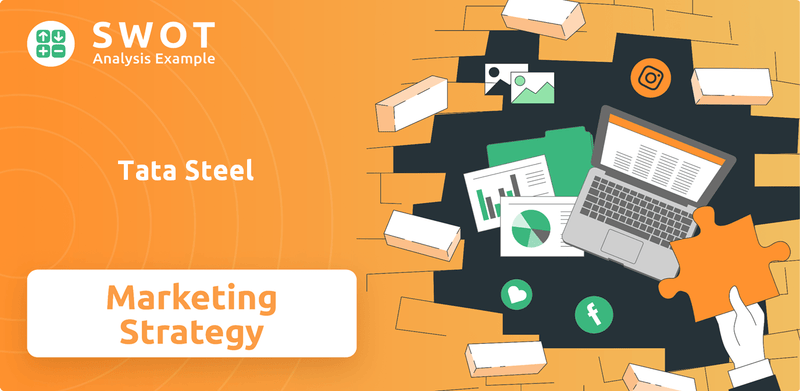
This exploration delves into the core of Tata Steel's Tata Steel SWOT Analysis, examining its sales performance, marketing plan, and overall strategy. We'll uncover its sales and marketing objectives, target market analysis, and how it leverages digital marketing strategy, customer relationship management, and various product promotion strategies. The recent financial results, including a substantial profit increase in Q4 FY2025, underscore the effectiveness of its strategic initiatives and provide a glimpse into its future growth strategy and market share ambitions, making it a compelling case study in modern business.
How Does Tata Steel Reach Its Customers?
The sales channels of the company, a major player in the steel industry, are designed to reach a diverse customer base through both online and offline methods. The company's distribution network includes a variety of channels, such as direct sales teams, wholesale distributors, and service centers. This robust network is supported by approximately 80,500 employees, ensuring extensive market coverage.
The company's sales strategy focuses on three main segments: B2B customers, B2ECA (small and medium-sized enterprises), and B2C consumers. The B2B segment accounts for about 60% of sales, covering industries like automotive and construction. The B2ECA sector represents around 20%, and the B2C segment also contributes about 20% of the sales, reflecting a growing emphasis on direct consumer engagement.
The company's strategy has evolved to include digital adoption and omnichannel integration. For B2C consumers, the e-commerce platform, Aashiyana, allows direct purchases, aiming to simplify the buying process and ensure quick deliveries across India. The company's focus on a comprehensive approach is evident in its detailed market analysis and strategic planning.
Aashiyana, the e-commerce platform, enables direct sales to individual home builders. It simplifies the steel purchasing process, making it as easy as buying other home components. Deliveries are guaranteed within 72 hours across India, enhancing customer satisfaction and convenience.
The company has established a transaction management system and value-added supply chain management services for B2B clients. For B2ECA, the DigECA platform offers online pricing, negotiation, and efficient delivery of premium steel products. The Urja program provides unsecured working capital finance to MSMEs and ECA customers.
The company's digital initiatives are crucial for expanding its market reach and enhancing customer experiences. The DigECA platform supports MSMEs with online tools and services. The Nexus portal in the UK provides B2B customers with 24/7 account management and order tracking capabilities.
Revenues from the Aashiyana platform increased by 60% year-on-year to ₹3,550 crores in FY2025. This growth highlights the effectiveness of the company's digital sales strategy and its ability to meet the evolving needs of its customers. The company's focus on digital marketing strategy has been instrumental in driving sales.
The company employs a multi-channel sales approach including direct sales, distributors, and digital platforms. The e-commerce platform, Aashiyana, targets B2C customers, while DigECA caters to B2ECA clients. The company's sales team structure is designed to support these diverse channels.
- Direct Sales Teams: Engage with key B2B customers.
- Wholesale Distributors: Serve a wide range of customers.
- E-commerce Platforms: Provide direct access for B2C and B2ECA customers.
- Service Centers: Offer value-added services.
Tata Steel SWOT Analysis
- Complete SWOT Breakdown
- Fully Customizable
- Editable in Excel & Word
- Professional Formatting
- Investor-Ready Format
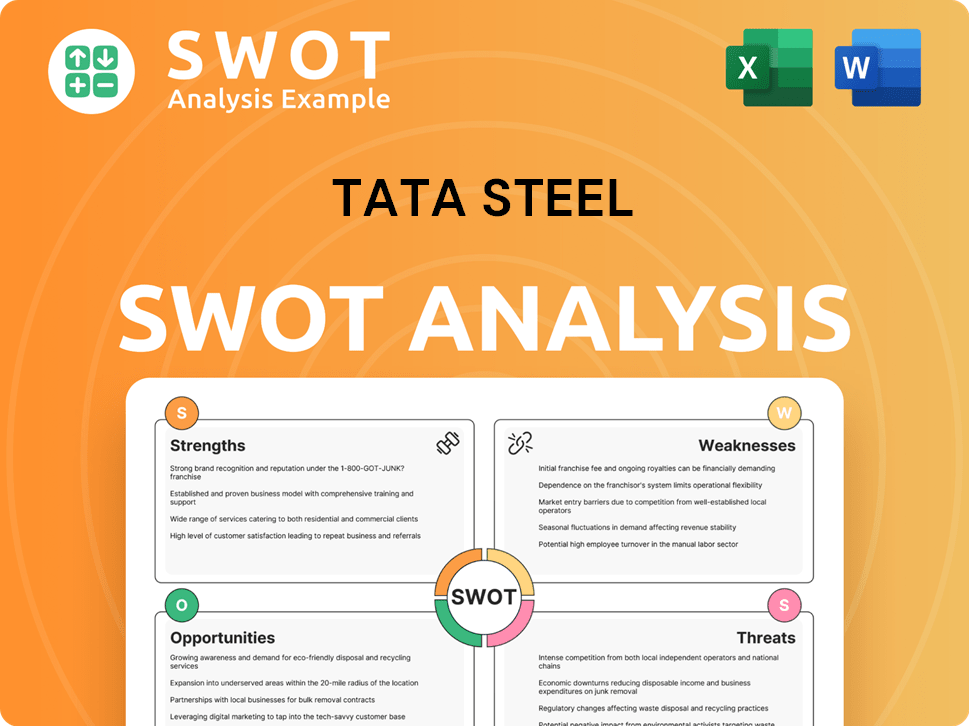
What Marketing Tactics Does Tata Steel Use?
The marketing tactics of the company involve a blend of digital and traditional methods, aiming to boost awareness, generate leads, and drive sales, especially within its B2B market. Their approach is rooted in data-driven marketing, customer segmentation, and personalization, ensuring they reach the right audience with the right message. This strategy is a key component of their overall Growth Strategy of Tata Steel.
Digital channels play a significant role, with content marketing, SEO, SEM, paid advertising, and email marketing forming the core of their online presence. They also maintain a strong presence on social media platforms like LinkedIn, Twitter, and Facebook to share industry insights and engage with stakeholders. For B2C customers, they use platforms like Aashiyana to provide informative content through articles and blogs. For B2B clients, they offer cross-sell opportunities and digital access to test certificates and account information.
Traditional media, including TV commercials, radio, and print ads, have been used to connect with customers, often employing taglines like 'Customer First-Har Haal Mein.' The company's digital transformation initiative, aiming to be a leader in 'Digital Steelmaking by 2025', involves creating a digital roadmap and prioritizing initiatives based on value and feasibility. This includes digitizing factories with 'digital twins' and using real-time analytics to create 'smart factories', enhancing customer engagement, streamlining operations, and enabling data-driven decision-making across B2B, B2ECA, and B2C segments.
The company focuses heavily on digital marketing, utilizing SEO, SEM, and content marketing to improve online visibility. They employ paid advertising campaigns to target specific customer segments and drive traffic to their website.
Active on platforms like LinkedIn, Twitter, and Facebook, the company shares industry updates, engages with stakeholders, and builds brand awareness. Social media helps them maintain customer relationships and promote products.
Traditional media, such as TV commercials and print ads, are used to reach a broader audience and create emotional connections. These campaigns often feature taglines that emphasize customer-centric values.
The company tailors its marketing efforts to both B2B and B2C segments. For B2B clients, they provide digital access to important documents and offer cross-sell opportunities. For B2C customers, they use platforms like Aashiyana to offer educational content.
The company is committed to digital transformation, aiming to be a leader in 'Digital Steelmaking by 2025'. This involves digitizing factories with 'digital twins' and using data analytics for smart manufacturing.
Technology platforms and analytics tools are used to enhance customer engagement, streamline operations, and enable data-driven decision-making. This approach helps improve efficiency and customer satisfaction.
The company employs a multifaceted approach to marketing, combining digital and traditional methods to reach its target audience effectively. This strategy supports the company's overall sales and marketing objectives.
- Content Marketing: Creating valuable content to attract and engage customers.
- SEO/SEM: Optimizing online presence for search engines to drive organic and paid traffic.
- Social Media Marketing: Utilizing platforms like LinkedIn, Twitter, and Facebook for brand building and customer engagement.
- Traditional Advertising: Employing TV, radio, and print ads to reach a broader audience.
- Data Analytics: Using data to inform marketing decisions and improve customer targeting.
- Customer Segmentation: Tailoring marketing efforts to different customer groups (B2B and B2C).
Tata Steel PESTLE Analysis
- Covers All 6 PESTLE Categories
- No Research Needed – Save Hours of Work
- Built by Experts, Trusted by Consultants
- Instant Download, Ready to Use
- 100% Editable, Fully Customizable
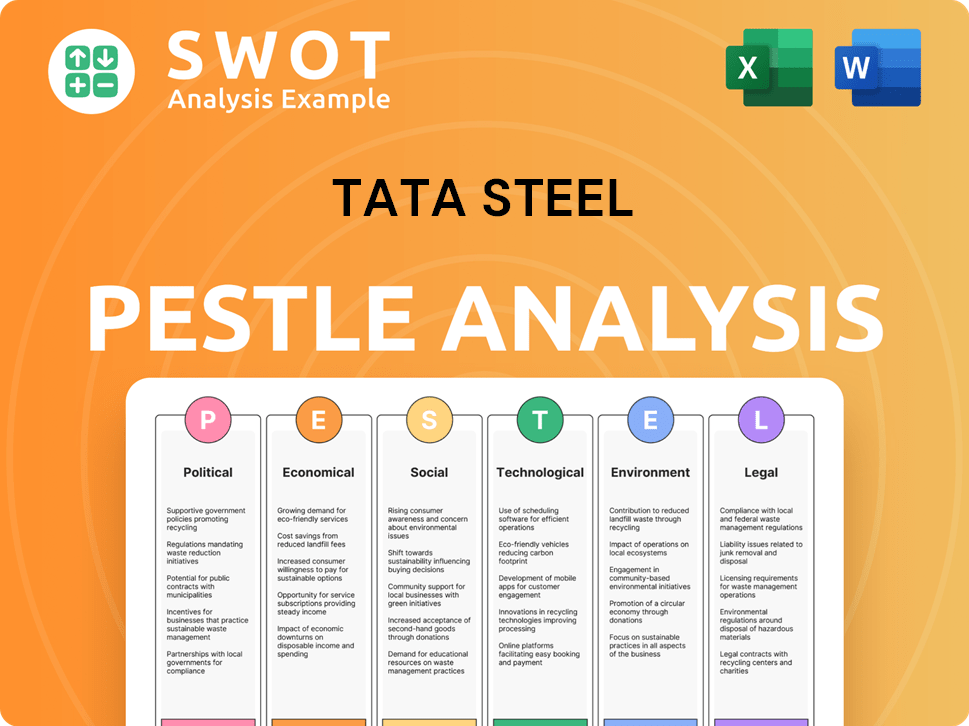
How Is Tata Steel Positioned in the Market?
The brand positioning of the company is centered on quality, reliability, and innovation, which sets it apart in the steel industry. The company has shifted from selling raw materials to marketing branded products, starting with Tata Shaktee in 2000, and expanding to include Tata Tiscon, Tata Steelium, and Tata Pipes. This branding strategy has been successful in increasing sales and market share. The core message often focuses on 'Customer First,' a tagline introduced in the late 1990s, highlighting a strong customer focus.
The company appeals to its target audience through value, innovation, and sustainability. Production strategies have focused on ensuring raw material safety, making it a low-cost manufacturer in Asia, which contributes to its cost competitiveness and efficiency. A recent development is its commitment to sustainability, demonstrated by the launch of 'Zeremis,' a brand for its green steel solutions. This initiative, including products like Zeremis Carbon Lite, underscores the company's commitment to decarbonization and a circular economy.
The visual identity for Zeremis features an unbreakable line, symbolizing the journey towards decarbonization. This strong brand consistency across channels and touchpoints, coupled with its focus on sustainability and customer needs, allows the company to respond to shifts in consumer sentiment and competitive threats effectively. For more insights into the company's structure, consider exploring Owners & Shareholders of Tata Steel.
The company's sales strategy emphasizes branded products like Tata Tiscon and Tata Shaktee. This approach aims to increase market share and customer loyalty. The focus on customer needs and quality is a key driver of sales performance.
The marketing strategy involves promoting branded products and communicating the value proposition of quality and reliability. Digital marketing, including social media and online advertising, is likely a component of their marketing plan. The launch of Zeremis also indicates a focus on sustainability in marketing campaigns.
The 'Customer First' approach is a core element of the company's strategy. This involves understanding customer needs and providing high-quality products and services. Customer relationship management (CRM) systems likely play a role in managing customer interactions.
The 'Zeremis' brand and related initiatives demonstrate a commitment to sustainability. This includes efforts to reduce carbon emissions and promote a circular economy. This focus is becoming increasingly important in the market.
The company’s brand positioning strategy is built on several key pillars. These elements work together to create a strong brand identity and drive market success. Here are the main components:
- Quality and Reliability: The brand is synonymous with high-quality steel products that customers can depend on.
- Innovation: The company continually invests in new technologies and processes to develop innovative products and solutions.
- Customer Focus: The 'Customer First' approach prioritizes meeting customer needs and building strong relationships.
- Sustainability: The company is committed to reducing its environmental impact and promoting sustainable practices.
- Branded Products: Marketing branded products like Tata Tiscon and Tata Shaktee to increase market share.
Tata Steel Business Model Canvas
- Complete 9-Block Business Model Canvas
- Effortlessly Communicate Your Business Strategy
- Investor-Ready BMC Format
- 100% Editable and Customizable
- Clear and Structured Layout
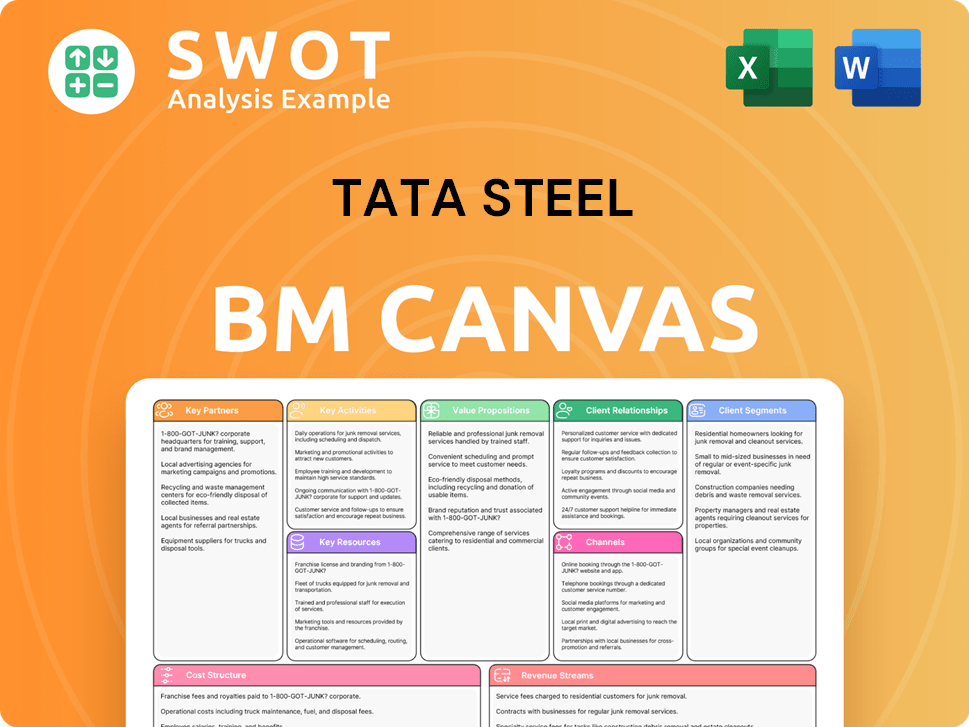
What Are Tata Steel’s Most Notable Campaigns?
The sales and marketing strategies employed by Tata Steel are multifaceted, designed to resonate with customers while driving growth. These strategies include emotional campaigns and practical solutions, reflecting a deep understanding of market dynamics. The company's approach focuses on building strong customer relationships and adapting to evolving market trends, ensuring its continued success. Understanding these strategies is crucial for anyone analyzing the Competitors Landscape of Tata Steel.
Tata Steel's marketing efforts are not just about selling steel; they are about creating a brand that customers trust and value. Through targeted campaigns, the company aims to connect with its audience on an emotional level, showcasing its commitment to customers. This approach is combined with a focus on providing innovative solutions that meet the needs of its diverse customer base. The company's dedication to sustainability and customer-centricity is a key part of its overall Tata Steel Strategy.
Tata Steel's commitment to customer-centricity is evident in its consistent marketing campaigns and initiatives. These efforts are designed to enhance customer relationships and drive sales performance. By understanding the needs of its customers, Tata Steel has successfully maintained a strong market position, demonstrating its adaptability and forward-thinking approach. The company's strategic decisions are crucial for its Tata Steel Sales Strategy and Tata Steel Marketing Strategy.
This campaign was launched to connect with customers on an emotional level, expressing gratitude to COVID-19 warriors. It demonstrated Tata Steel's commitment to social responsibility and strengthened its brand image. The campaign aimed to build goodwill and foster a sense of community among its customers.
This long-standing theme emphasizes the company's unwavering commitment to its customers. It underscores the importance of customer satisfaction and building lasting relationships. The theme is a core principle of Tata Steel's business philosophy, guiding its sales and marketing efforts.
Launched in February 2025, this campaign focuses on decarbonizing steel production for the packaging sector. It involves showcasing Electric Arc Furnace (EAF) technology through virtual reality tours. The campaign aims to produce packaging steel with 50% lower CO2 emissions and at least 50% recycled content by 2030.
Launched in July 2023 on the DigECA platform, the Urja program provides unsecured working capital finance to MSMEs and ECA customers of Tata Steel distributors. This initiative supports their growth and strengthens relationships. It is a key part of the company's strategy to support its supply chain and promote economic development.
These campaigns demonstrate Tata Steel's focus on emotional connections and practical solutions. They align with current market trends and sustainability goals. The company's Tata Steel Marketing Plan includes these initiatives to boost Tata Steel Sales Performance.
- Enhancing brand image through emotional campaigns.
- Promoting sustainable practices to meet environmental goals.
- Supporting MSMEs through financial assistance, fostering growth.
- Strengthening customer relationships and driving sales.
Tata Steel Porter's Five Forces Analysis
- Covers All 5 Competitive Forces in Detail
- Structured for Consultants, Students, and Founders
- 100% Editable in Microsoft Word & Excel
- Instant Digital Download – Use Immediately
- Compatible with Mac & PC – Fully Unlocked
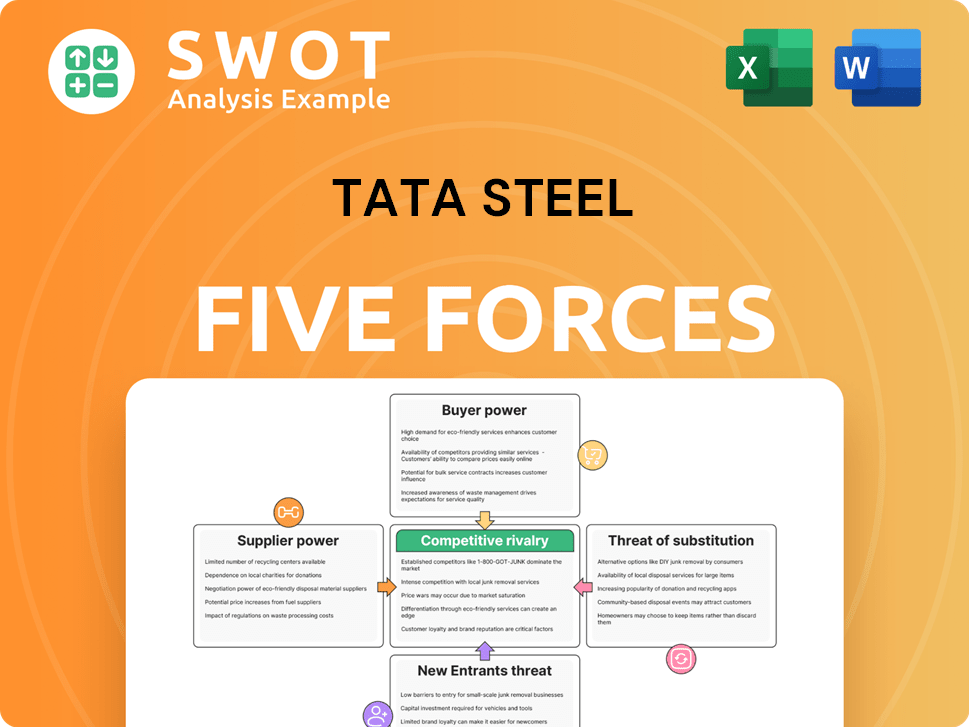
Related Blogs
- What are Mission Vision & Core Values of Tata Steel Company?
- What is Competitive Landscape of Tata Steel Company?
- What is Growth Strategy and Future Prospects of Tata Steel Company?
- How Does Tata Steel Company Work?
- What is Brief History of Tata Steel Company?
- Who Owns Tata Steel Company?
- What is Customer Demographics and Target Market of Tata Steel Company?
Disclaimer
All information, articles, and product details provided on this website are for general informational and educational purposes only. We do not claim any ownership over, nor do we intend to infringe upon, any trademarks, copyrights, logos, brand names, or other intellectual property mentioned or depicted on this site. Such intellectual property remains the property of its respective owners, and any references here are made solely for identification or informational purposes, without implying any affiliation, endorsement, or partnership.
We make no representations or warranties, express or implied, regarding the accuracy, completeness, or suitability of any content or products presented. Nothing on this website should be construed as legal, tax, investment, financial, medical, or other professional advice. In addition, no part of this site—including articles or product references—constitutes a solicitation, recommendation, endorsement, advertisement, or offer to buy or sell any securities, franchises, or other financial instruments, particularly in jurisdictions where such activity would be unlawful.
All content is of a general nature and may not address the specific circumstances of any individual or entity. It is not a substitute for professional advice or services. Any actions you take based on the information provided here are strictly at your own risk. You accept full responsibility for any decisions or outcomes arising from your use of this website and agree to release us from any liability in connection with your use of, or reliance upon, the content or products found herein.